Baggott J. The Meaning of Quantum Theory: A Guide for Students of Chemistry and Physics
Подождите немного. Документ загружается.


98
What
does
it
mean?
In
this'
equation,
[q"PAI
= [q.,PBJ =
if!
(lhc pOslllOlI·-momenlurn
commutation
relation)
and
(qA'P.]
=
[q"PAI
= 0, since these opera-
,
tors refer
to
different
quantum
particles. Hence, [Q,
PJ
=
0,
the opera-
A
lors
Q
and
P
commute
and
there is
no
restrictIOn on the precision with
which we
can
measure
the
difference betWeen the positions
of
particles
A
and
B
and
the
sum
of
their
momenta.
A
reasonable
definition
of
reality
EPR
allowed themselves
what
seems
at
fjrst sight to be a· fairly reason-
able definition
of
physical reality: I
If,
without
in
any
way
disturbing
a system,
we
can
predict with certainty
(i
e,
with a probability equal to unity) the value
of
a physical quantity. Ihen there
exists an element
of
physical reality
corresponding
to
this physicai quantity.
The
purpose
of
this
statement
is
to
make
clear that
for
each
particle
considered individllally, the
measurement
of
one
physical
quantity
(the
position
of
E,
say) with certainty
(Aq.
=
0)
implies
an
infinite uncer-
tainty
in its
momentum
(since D.p.
~
hI4"C:.q,).
Therefore,
according
to
EPR's
definition
of
reality, under these circumstances the position
of
panicle
B
is
an
element
of
physical reality
but
the
momentum
is
"m.
Obviously,
by
choosing to
perform
a
different
measurement,
we
can
establish the
reality
of
tile
momentum
qf
panicle
B
but
not
its position.
The
Copenhagen
interpretation
of
quantum
theory
insists
that
we
can
establish tbe reality
of
one
or
the
other
of
two
complementary
physical
quantities
but
not
both
simultaneously.
But we have shown above
that
the difference in
the
positions
of
particles A
and
B
and
the
sum
of
their
momenta
are quantities whose
operators
commute.
The
Copenhagen
interpretation says
that
we
can
therefore establish the physical reality
of
these quantities simulta-
neously.
It
is enough for
the
EPR
argument
that
these quantities are
simultaneously real
in
principle,
although
their actual determination
might require a physical measurement.
Now
suppose
we
allow
the
two
particles to interact
and
move a long
distance
apart.
We
perform
an experiment on particle A
to
measure its
position with certainty. We know
that
(qA
-
qB)
must
be a physically
real
quantity
and
so we can in principle deduce the position
of
particle
B also with certainty.
We
therefore
conclude
that
q.
must
be
an
element
of
physical reality
according
to
the
EPR
definition. However, suppose
instead
that
we choose
to
measure the
momentum
of
particle A with
I Einslein,
A"
Podolsky,
B.
and
Rosen.
N.
(935).
Physical Review.
41~
177.
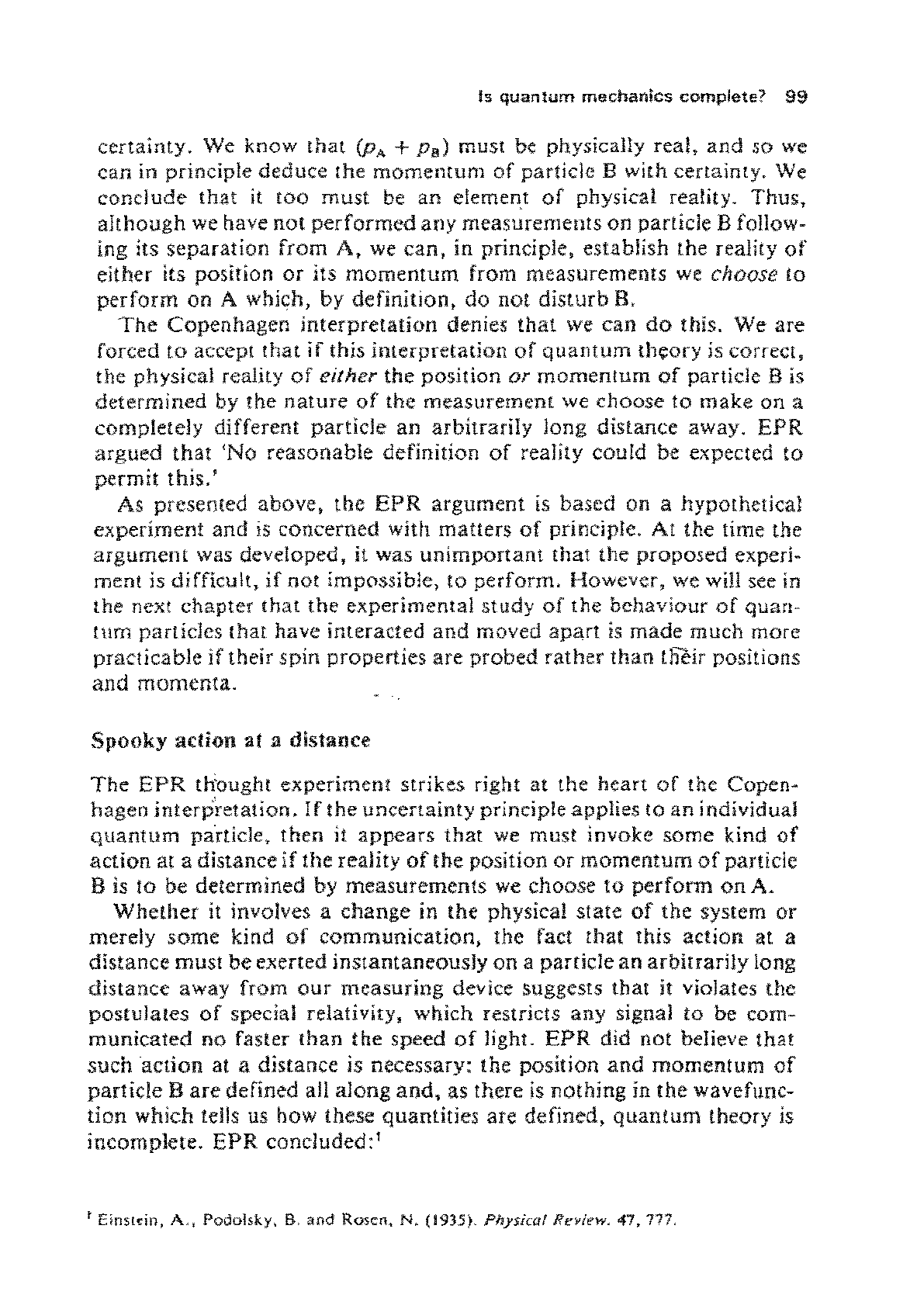
Is
quantum
mechanics
complete?
99
certainty. We know
that
(PA
+
p.l
must be physically real,
and
so
we
can
in principle deduce the
momentum
of
particle B with certainty. We
conclude
that
it
[00
must
be
an
element
of
physical reality. Thus,
although
we
have
not
performed
any
measurements
on
particle B follow-
ing its separation from
A,
we
can,
in principle, establish the reality
of
either its position
or
its
momentum
from measurements
we
choose to
perform
on
A which,
by
definition,
do
not
disturb
B.
The
Copenhagen
interpretation
denies
that
we
can
do
this.
We
are
forced
to
accept
that
if
this
interpretation
of
quantum
theory
is
correct,
the physical reality
of
either the position or
momentum
of
particle B
is
determined
by the
nature
of
the measurement we
choose
to
make
on
a
completely different
particle
an arbitrarily long distance away.
EPR
argued
that
'No
reasonable definition
of
reality could be expected
to
permit
this.'
As presented above, the
EPR
argument
is
based on a hypothetical
experiment
anc!
is
concerned with
matters
of
princip!e.
At
the time the
argument
was developed, it was
unimportant
that
the proposed experi.
ment is difficult,
if
not
impossible, to
perform.
However,
we
will see in
the next chapter
that
the experimental study
of
the behaviour
of
quan-
tum
particles that have interacted
and
moved
apart
is
made much more
practicable
jf
their spin properties
are
probed
rather
than
tfieir positions
and
momenta.
Spooky
action
at
a distance
The
EPR
thought experiment strikes right
at
the
heart
of
the Copen-
hagen
inteq:iretation.
If
the uncertainty principle applies to
an
individual
quantum
pa·rticle, then it
appears
that
we
must invoke
some
kind
of
action
at a distance if the reality
of
the position
or
momentum
of
particle
B
is
to
be determined by
measurements
we
choose
to
perfonn
on
A.
Whether
it
involves a
change
in the physical
state
of
the system
or
merely
some
kind
of
communication,
the fact
that
this action at a
distance must be exerted
instantaneously
on
a particle an
arbitrarily
long
distance
away from
our
measuring device suggests
that
it violates the
postulates
of
special relativity, which restricts any signal
to
be com-
municated
no
faster
than
the speed
of
light.
EPR
did no! believe
that
such
action
at a distance is necessary: the position
and
momentum
of
particle B
are
defined all
along
and,
as there
is
nothing in
the
wavefunc-
tion
which tells us how these quantities are defined,
quantum
theory is
incomplete.
EPR
concluded:'
t
E~nstein,
A", Podolsky,
B,
and
Rosen,
N.
(l935)~
Physical Review.
47.717,
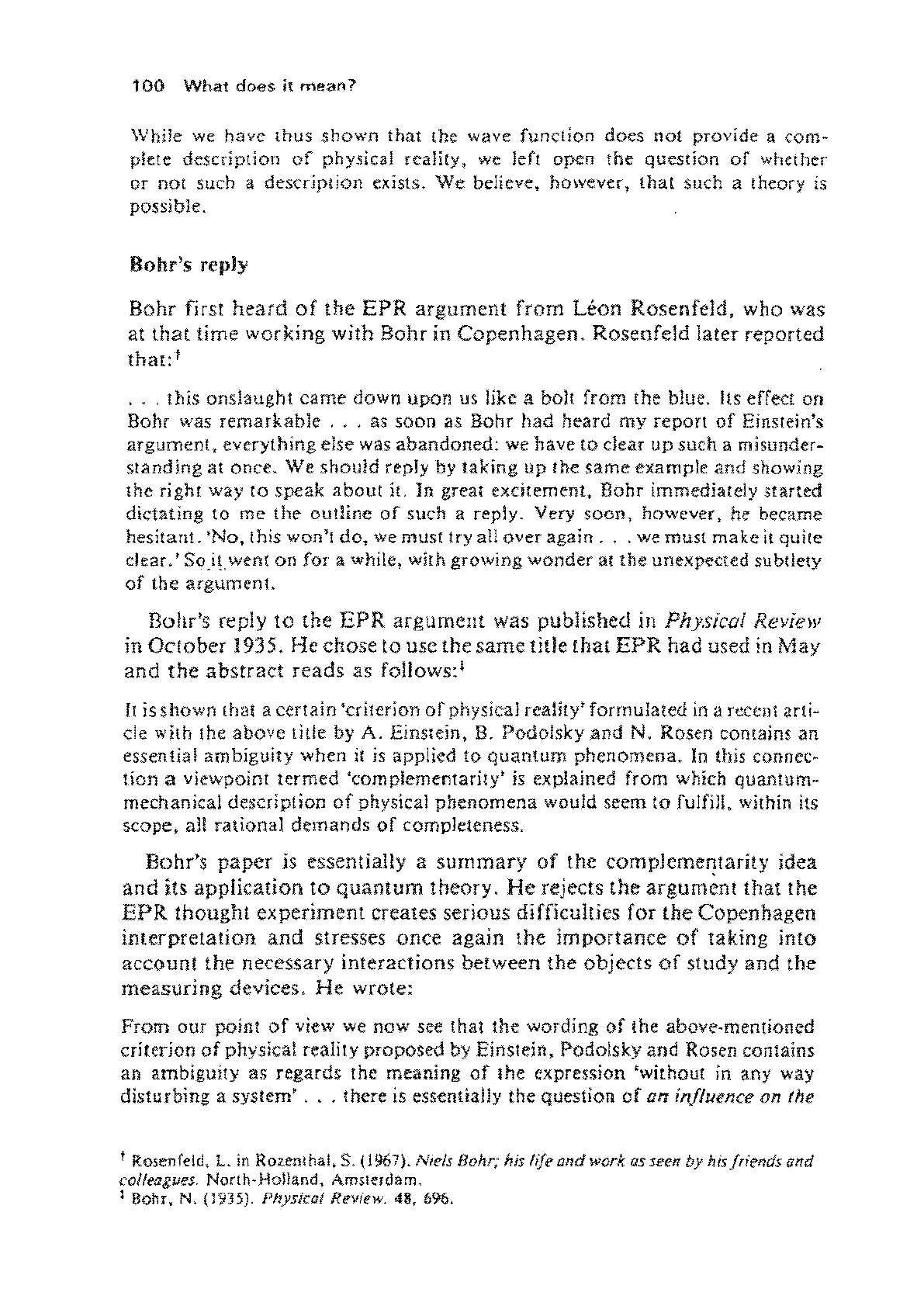
100
What
does
it
mean?
\Vhile we
have
thus
shown
that
the wave
function
does
not
provide a
com-
plete description
of
physical reality,
we
left open
the
question
of
whether
or
not
such a
descrjplion
exists.
We
believe. however 1
that
such a theory
is
possible.
Bohr's
repJy
Bohr
first
heard
of
the
EPR
argument
from
Leon Rosenfeld, who was
at
that
time
working
with Bohr in
Copenhagen.
Rosenfeld later reported
that: '
...
this onslaught came down upon
us
Ilke a bolt from the blue. Its effect on
Bohr
was
remarkable
...
as
soon as Bohr had heard
my
repon
of
Einstein's
argument,
everything
else was
abandoned:
we
have
to
dear
up
such a misunder-
standing at once.
We
should reply by taking up lhe same example and showing
the right
way
to
speak aboul it. In great excitement, Bohr immediately started
dictating
to
me
the
oUlline
of
such a reply. Very
soon,
however, he became
hesitant.
'No,
this won'j
do~
we must try
aU
over
again.
,
,we
must
make
it
quite
clear.'
So)twent
on
for
a while, with
growing
wonder
at
the
unexpected subtlety
of
the argument.
Bohr's reply
to
the
EPR
argument
was published in PhYSical Review
in
October
1935.
He
chose to use the
same
title
that
EPR
had
used;n
May
and
the
abstract
reads
as follows,'
It
is
shown
that a
certain
'criterlon
or
physicaJ reallty'
formulated
in a receni arti-
cle with the
above
title
by
A. Eins;ein,
B.
Podolsky
and
N.
Rosen
contains an
essential
ambiguity
when
it
is
applied
to
Quantum
phenomena.
In
this
connec~
tion a viewpoint
termed
'complementarity'
is
explajned from which
quantum-
mechanical
description
of
physicaJ
phenomena
would seem
to
fulfill. within its
scope,
aU
rational
demands
of
completeness.
Bohr's paper is essentially a
summary
of
the
comp]cmemarity
idea
and
its
application
to
quantum
theory.
He
rejects
the
argument
that
the
EPR
thought
experiment
creates serious difficulties for
the
Copenhagen
interpretation
and
stresses
once
again
the
importance
of
taking
into
accounl the necessary interactions between the objects
of
study
and
the
measuring
devices.
He
wrote:
From
our
point
of
view we
now
see
that
the
wording
of
the
abovC'~mentioned
criterion
of
physical reality proposed by Einstein, PodolSky and
Rosen
contains
an
ambiguity
as
regards
the meaning
of
~he
expression
'without
in
any
way
disturbing
a
system'
,
..
there is essentially
the
question
of
an
influence on the
f Rosenfeld,
L.
in Rozenlhal.
S,
(1967).
Niels
Bohr.' his flJe
and
work
as
seen
by
hisjrif!rlds
(Jl1d
colleagues. North-Holland, Amslerdam.
1 Bohr.
N.
(935).
Physical
Review. 48, 696,
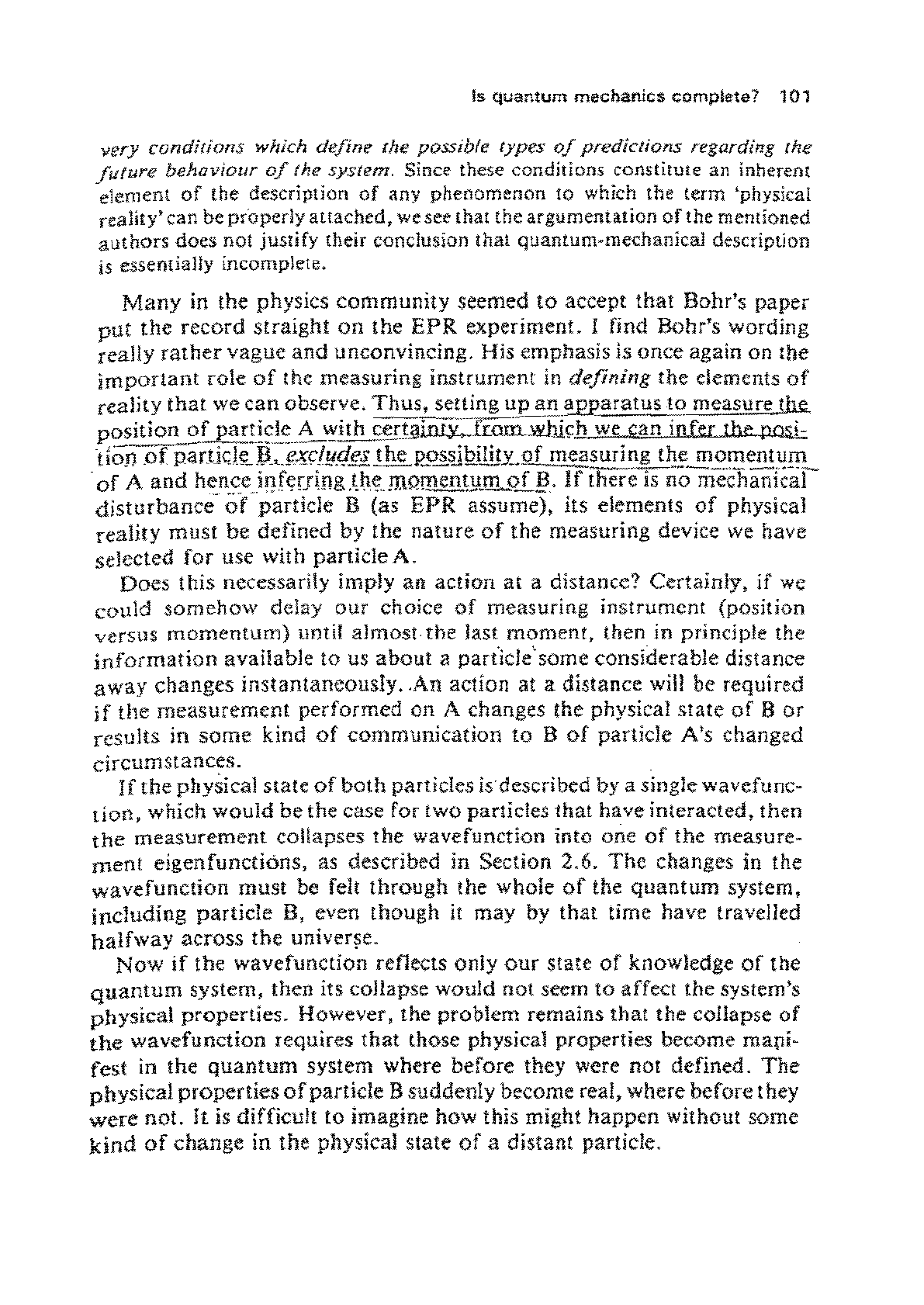
Is.
quantum
mechanics
complete?
101
very conditions wilieh define the possible types
of
predictions regarding Iile
future
behaviour
of
the system. Since these conditions constitute an inherent
element
of
the description
of
any phenomenon
to
which the term 'physical
reality' can be
pr'Qperiy
attached,
wesee
that the argumentation
of
the mentioned
authors
does
not justify their concluslon that
quanturn~mechanical
description
is
essentially incomplete.
Many
in the physics
community
seemed
to
accept
that
Bohr's paper
put
the
record straight
on
the EPR experiment. I find Bohr's wording
really
rather
vague and unconvincing. His emphasis is
once
again on the
important
role
of
the measuring instrument in defining the elements
of
reality
that
we
can
observe.
Thus,
setting
up--"n
.'!£Paratus
to
measure the
position..'.'.f
l?ar!!~~e~_",ith
ce..rt1!inci,::lliii.ii.~ch
we
~an
infer the posi:
donor
par.tj<;I~_p~>.j?~cl!'4es
!he
p.5'2.~bi.lliy_9..f
measuring the momentum
of
A and hence inf,rJing.(ht!Il.QroenDJ.m.Qf.!l.
I(rhere
is
no!iiecha:nlcal
disltlrbance'
of
particle
B (as EPR assume), its elements
of
physical
reality must be defined by the nature
of
the measuring device
we
have
selected
for
use with particle A.
Does this necessarily imply
an action at a distance? Certainly,
if
we
could
somehow delay
our
choice
of
measuring instrument (position
versus
momentum)
until almost the last moment, then in principle the
information
available
to
us
about
a pariicle'some considerable distance
away
changes instantaneously
..
An action at a distance will be required
if
the
measurement performed on A changes the physical state
of
B
or
results in
some
kind
of
communication
to
B
of
particle A's changed
circumstances.
If
the
physical state
of
both
particles
is
described by a single wavefunc·
lion,
which would be the case for two particles
that
have interacted, then
the
measurement collapses
the
wave function into one
of
the measure·
ment
eigenfunctions, as described in Section 2.6.
The
changes in the
wavefunction must
be felt through the whole
of
the
quantum
system,
including particle
B,
even though
it
may by that time have travelled
halfway
across the
univer~e.
Now
if
the wavefunction reflects only
our
state
of
knowledge
of
the
quantum
system, then its collapse would not seem
to
affect the system's
physical
properties~
However, the problem remains
that
the collapse
of
the
wavefunction requires
that
those physical properties become mapi·
fest in the
quantum
system where before they were not defined.
The
physical properties
of
particle B suddenly become real, where before they
were
not.
It
is difficult
to
imagine how this might happen without some
kind
of
change in the physical state
of
a distant particle.
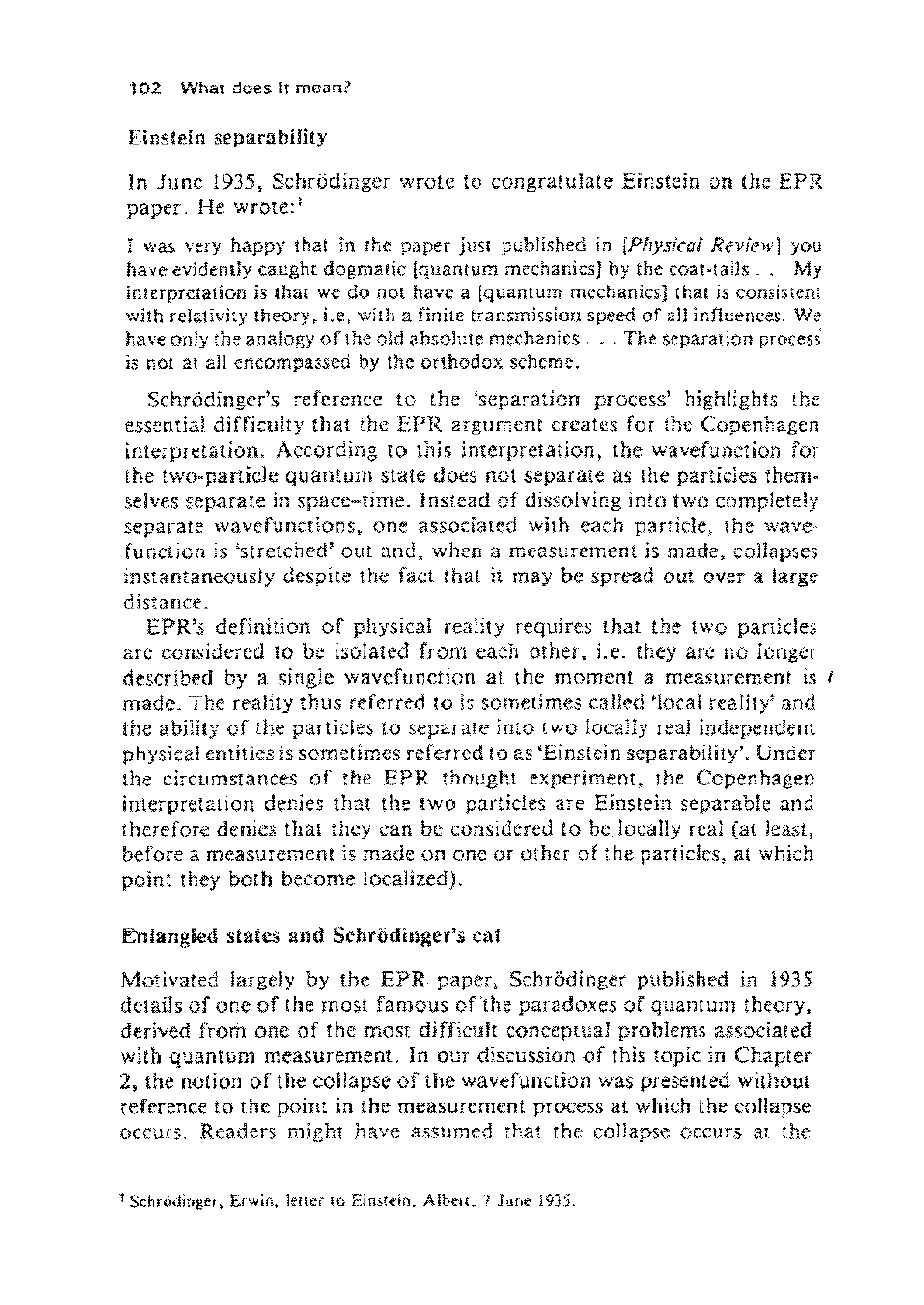
102
What
does
it
mean?
Einstein separability
In
June
1935, Schriidinger wrote to
congratulate
Einstein on the
EPR
paper, He
wrote:'
I was
very
happy
that in
the
paper just published
in
[Physical Review]
you
have evidently caught dogmatic [quantum mechanics]
by
the coat·tails
...
My
interpretation
is
that we
do
not
have a
!quantum
mechanics]
that
is
consistent
with
relativity
tl1eory~
I.e, with a finite transmission speed
of
aU
influences, We
have
only the analogy
of
the old absolute mechanics
...
The
separalion process
lS
not at all encompassed by the
orthodox
scheme.
Schr6dinger's reference
to
the
'separation process' highlights the
essential difficulty
that
the
EPR
argument creates for the Copenhagen
interpretation. According
to
this interpretation,
the
wavefunction for
the
two-particle
quantum
state
does not separate as the particles them·
selves separate
in
space-time.
Instead
of
dissolving into two completely
separate wavefullctions,
one
associated with each particle, the wave·
function
is
'stretched'
out
and,
when a measurement
is
made, collapses
instantaneously despite
the
fact that it may
be
spread Ollt over a large
distance.
EPR's definition
of
physical reality requires
that
the
two panicles
are
considered
to
be isolated from each other, i.e. they are no longer
described by a single wavefunction
at
the moment a measurement
is
I
made.
The reality
thus
referred
to
is
sometimes called 'local reality' and
the
ability
of
the particles to
separate
imo
two locally real independent
physical entities is sometimes referred to as 'Einstein separability'. Under
the circumstances
of
the
EPR
thought experiment, the Copenhagen
interpretation denies that the
two
particles are Einstein separable and
therefore denies that they can be considered
to
be locally real (at least,
before
a measurement
is
made
on
one or
other
of
the
particles, at which
point they
both
become localized).
Entangled states
and
Scbr6dinger's cal
Motivated largely by
the
EPR
paper, Schrodinger published in
1935
details
of
one
of
the most famous
of
tile paradoxes
of
quantum theory,
derived from
one
of
Ihe most difficult conceptual problems associated
with
quantum
measurement.
In
our
discussion
of
this topic in Chapter
2, the notion
of
the collapse
of
the
wavefunction was presented without
reference to the
point
in
the
measurement process
at
which the collapse
occurs.
Readers might have assumed that the collapse occurs at the
t $chrodingel. Erwin,
lener
fO
Eimrefn.
Albert,
7 June 1935.
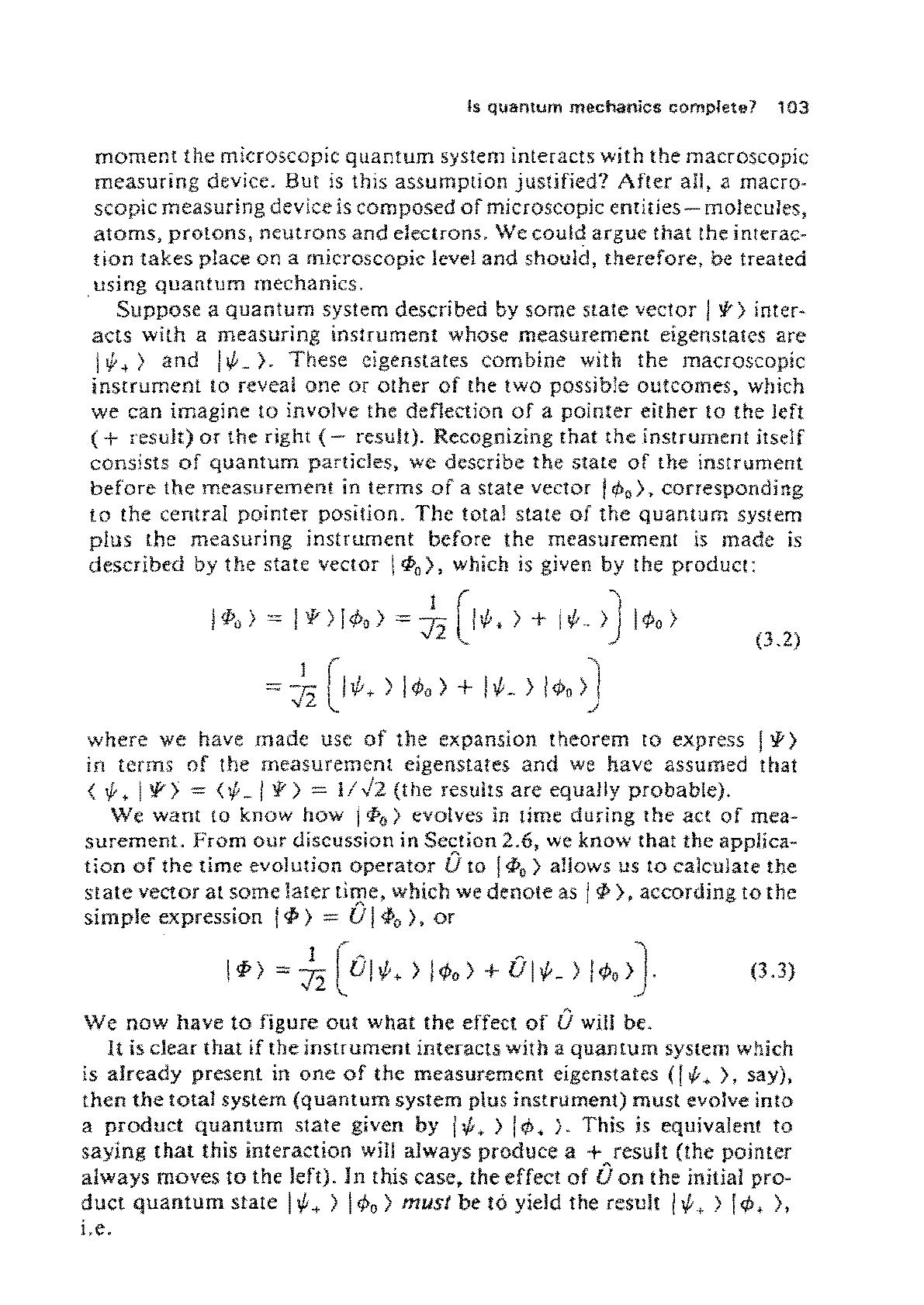
is quantum
mechanics
comptete?
103
moment
the
microscopic
quantum
system interacts with
the
macroscopic
measuring
device. But is this
assumption
justified?
After
ail, a macro-
scopic
measuring
device is
composed
of
microscopic
entities-
molecules,
atoms,
protons,
neutrons
and
electrons. We could
argue
that
the interac-
tion
takes
place
on
a microscopic level
and
should,
therefore,
be treated
using
quantum
mechanics.
Suppose
a
quantum
system described by
some
state
vector
I
r)
inter-
acts
with
a
measuring
instrument
whose
measurement
eigenstates
are
1 If. >
and
I
If.)·
These
eigenstates
combine
with
the
macroscopic
instrument
to reveal
one
or
other
of
the
two
possible
outcomes,
which
we
can
imagine
to
involve the deflection
of
a
pointer
either
to
the
left
(+
result)
or
the
right
(-
result). Recognizing
that
the
instrument
itself
consists
of
quantum
particles, we describe
the
state
of
the
instrument
before
the
measurement
in
terms
of
a
state
vector I
rf>o},
corresponding
to
the
central
pointer
position.
The
total
state
of
the
quantum
system
plus
the
measuring
instrument
before
the
measurement
is
made
IS
described
by
the
state
vector I
<Po},
which
is
given by the
product:
(3.2)
where
we have
made
use
of
the
expansion theorem
10
express I
'i')
in terms
of
the
measurement
eigenstate,
and
we
have
assumed that
( "', I
!Y>
= <
'"
_ I
'i')
=
1/,/2
(the
results
are
equally
probable).
We
wan! to know
how
I
q,o>
evolves
in
time
during
the
act
of
mea·
surement.
From
our
discussion in Section
2.6,
we
know
that
the
applica-
tion
of
the
time evolution
operator
(j
to
14>,)
allows
us
to calculate
the
state
vector
at
some
later
til)!e, which
we
denote
as I
q,
>,
according
to
the
simple
expression
14»
= U
14>0
),
or
J
(A
" J
14»
""71
UIIf.)
1<1>.)
+
UIIf.)
1<1>0>
.
(3.3)
Wc
now
have
to
figure
Oil!
what
Ihe effect
of
(j
will be.
lt
is clear
Ihal
if
the
instrument
interacts with a
quantum
system which
is
already
present in
one
of
the
measurement eigenstates
(I
>It.
),
say),
then
the
total
system
(quantum
system plus instrument)
must
evolve
into
a
product
quantum
state
given by
I¥-.
)
1<1>.
). This is equivalent
to
saying
that
this interaction
will
always
produce
a + result (the
pointer
always
moves
to
the left).
In
this case, the effect
of
(j
on
the initial pro-
duct
quantum
state
I
If
+ ) l.p,)
must
be
10
yield the result I If, ) I
<1>,
),
i.e.

104
What
does
it
mean?
Similarly.
Substituting
these last two expressions
into
eqn (3.3) gives
1
<P
> =
Jz
rl"'.)
IqI,
> +
1"'-
)
IqI-
>l
~
~
(3.4)
(3.5)
(3.6)
We now seem
to
be
no further
forward
than
before the measurement
was made.
Equation
(3.6) suggests
that
the measuring instrument evolves
into
a superposition
state
in
which
the
pointer
simultaneously points
both
to
the
left and
the
right. Collapsing the wavefunction
of
the system-
plus-measuring-device would seem
to
require a further measuremenl.
But then the whole argument can
be repreated
ad
infinitum. Are
we
therefore locked into an endless chain
of
measuring processes? At
what point does the chain stop (at
what
point does the wavefu!)ction
collapse)?
This
problem
is
created by
our
inability to
obtain
a collapse
of
the
wavefunction
using the continuous, deterministic
cquat~on
of
motion
A
from which
the
time evolution
operator
U
is
derived (see Section 2.6). I
Schrodinger called
the
state vector I
p)
as given in eqn (3.6) 'entangled'
because, once generated, it
is
impossible to
separate
it
into its constituent
parts
except by invoking all indeterministic collapse.
As
we
have seen,
such
a collapse
is
simply not accounted for in the equations
of
orthodox
quantum
theory.
The
paradox
of
Schrodillger's cat was designed
to
show
up
the
apparent·-absurdity·
of
this situation by shifting the focus from the
microscopic world
of
sub-atomic particles
to
the
macroscopic world
of
cats and
human
observers.
The
essential ingredients are shown in
Fig. 3.5. A cat is placed inside a steel
chambettogether
with a Geigertube
containing
a small
amount
of
radioactive substance. a
hammer
mounted
on a pivot
and
a
p!1ial
of
prussic acid.
The
chamber
is
closed. From the
amount
of
radioactive substance used
and
its known half-life.
we
expect
that
within
one
hour
Ihere
is
a probability
of
t that
one
atom has dis-
·integrated.
If
an
atom
does indeed disintegrate,
the
Geiger
counter
is
triggered. releasing the hammer which smashes the phial.
The
prussic
acid
is
released, killing
the
cat.
Prior
to
actually measuring
the
disintegration, the Slate vector
of
the
alom
of
radioactive substance must be expressed as a linear superposi-
tion
of
the
measurement eigenstates, corresponding
to
the physical states
of
the intact
atom
and
the
disintegrated
atom.
However. as
we
have seen
above. treating the measuring instrument
as a
quantum
object
and
using
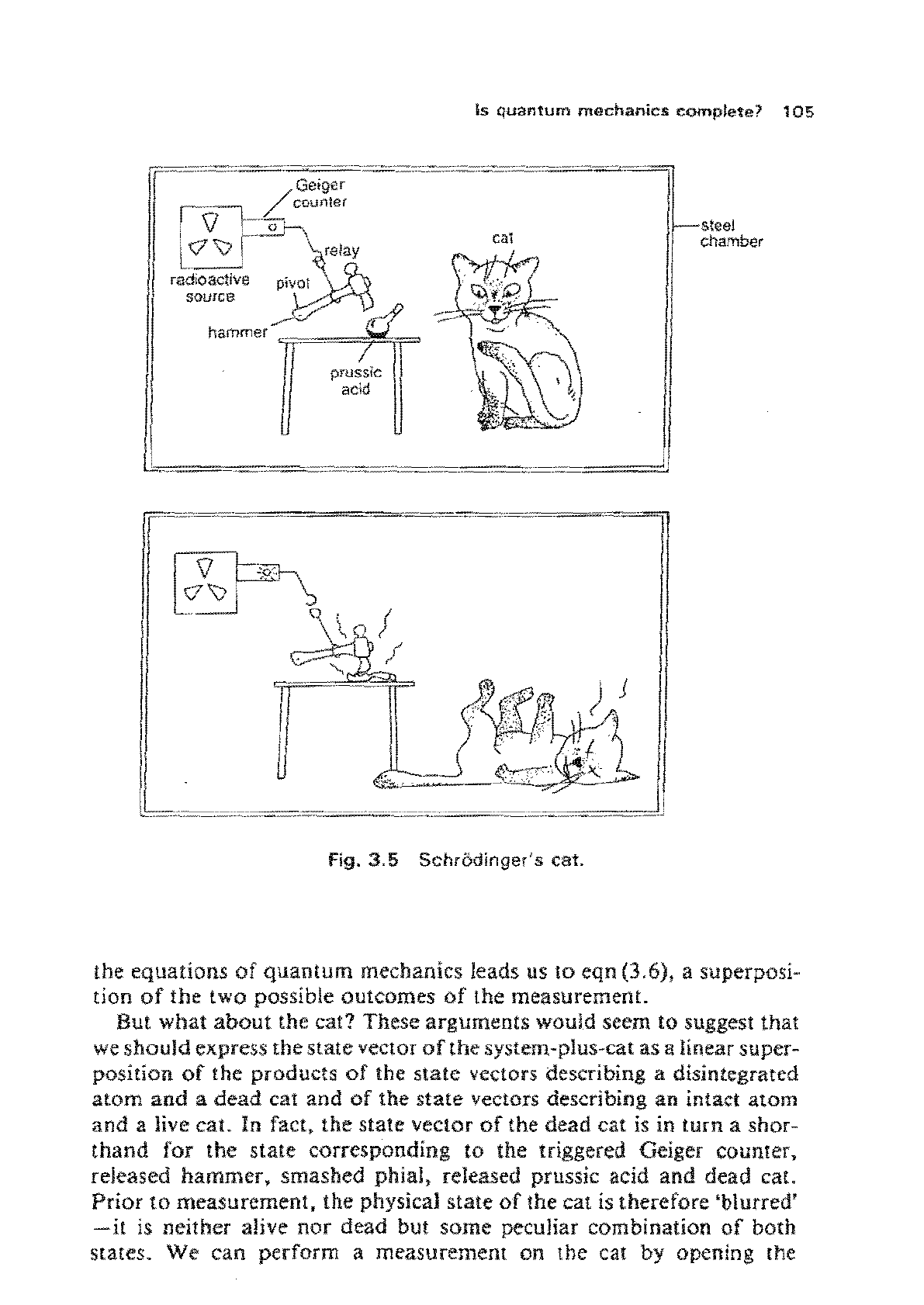
is Quantum
mechanics
complete?
105
Geiger
~"
__
::-I
/
coufller
I
\J
r-
o
LV\)
r~
r.'ay
radioactive
source
hammer
__
prussic
acid
cal
,==
..
__
.=
..
==
Fig.3.5
Schrodinger's
cat.
steel
chamber
the
equations
of
quantum
mechanics leads us
to
eqn
(3.6), a superposi·
tion
of
the
two possible outcomes
of
the measurement.
But
what
about
the cat? These arguments would seem
to
suggest that
We
should
express the state vector
of
the system-plus-cat as a linear super-
position
of
the products
of
Ihe
slale
veclors describing a disintegrated
atom
and
a
dead
cat
and
of
the
state
vectors describing an intact atom
and
a live cat. In fact,
the
stale vector
of
the dead cat is in
turn
a shor-
thand
for
the stale corresponding
to
the triggered Geiger counter,
released
hammer,
smashed phial, released prussic acid
and
dead cat.
Prior
to
measurement,
the
physical
state
of
the cat
is
therefore 'blurred'
-
it is neither alive
nor
dead but some peculiar combination
of
both
states.
We
can
perform a measurement
on
the cat
by
opening the

106
What
does
it
mean
l'
chamber
and
ascertaining its physical state.
Do
we suppose that, at that
point,
the state vector
of
the
system-plus-cat collapses
and
we record the
observation
that the cat is alive
or
dead as
appropriate?
Although
obviously intended to be
somewhat
tongue-in-cheek.
Sc!Jrodinger's
paradox
nevertheless brings
our
attention
to
an important
difficulty
that
we
must
confront.
The
Copenhagen
interpretation says
that
elements
of
an
empirical reality
are
defined by the
nature
of
the
experimental
apparatus
we construct to
perform
measurements on a
quantum
system.
It
insists that
we
resist the
temptation
to ask what
physical state a
panicle
(or
a cat) was actually
in
prior
to
measurement
as such
a question
is
quite
without meaning.
However,
this positivist interpretation sits
uncomfortably
with some
scientists. particularly those with a special fondness for cats. Some have
accepted the
EPR
argument
that
quantum
theory
is incomplete. They
have
set
about searching
for
an alternative
theory,
one
that allows us to
attach
physical significance
to
the properties
of
particles without the
need
to
specify the
nature
of
the measuring instrument, one that allows
us
to
define
an
independent reality and that reintroduces strict causality.
Even though
scarching for such a theory might be engaging
in
mean·
ingJess metaphysical speculation, they believe
that
it
is
a search that has
to
be
undertaken.
3.5
HIDDEN
VARIABLES
If
we reject the
'spooky'
action at a distance that seems to be required
in
the
Copenhagen
interpretation
of
quantum
theory,
and
which
is
high-
lighted
by
the
EPR
thought
experiment, then we must accept the
EPR
argument
that the theory is somehow incomplete. In essence, this
involves the rejection
of
the
first postulate
of
quantum
theory: the
state
of
a
quantum
mechanical system is not completely described by the
wavefunction.
Those
physicists who
in
the 19305 were
uncomfortable
with the
Copenhagen
interpretation
were faced with
two
options. Either they
could
scrap
quantum
theory completely
and
sIan
all over again
or
they
could try
to
extend the
theory
to reintroduce Slrict causality
and
local
reality. There was a general recognition
that
quantum
theory was too
good
to
be consigned
to
history's waste bin
of
scientific ideas.
The
theory
did
an
excellent
job
of
rationalizing the available experimental informa-
tion
on
the physics
of
the microscopic world
of
quantum
particles, and
its predictions
had
been shown
10
be consistently correct. What was
needed, therefore, was some means
of
adapting
the
theory to bring back
those aspects
of
classical physics that il appeared
to
lack.
I
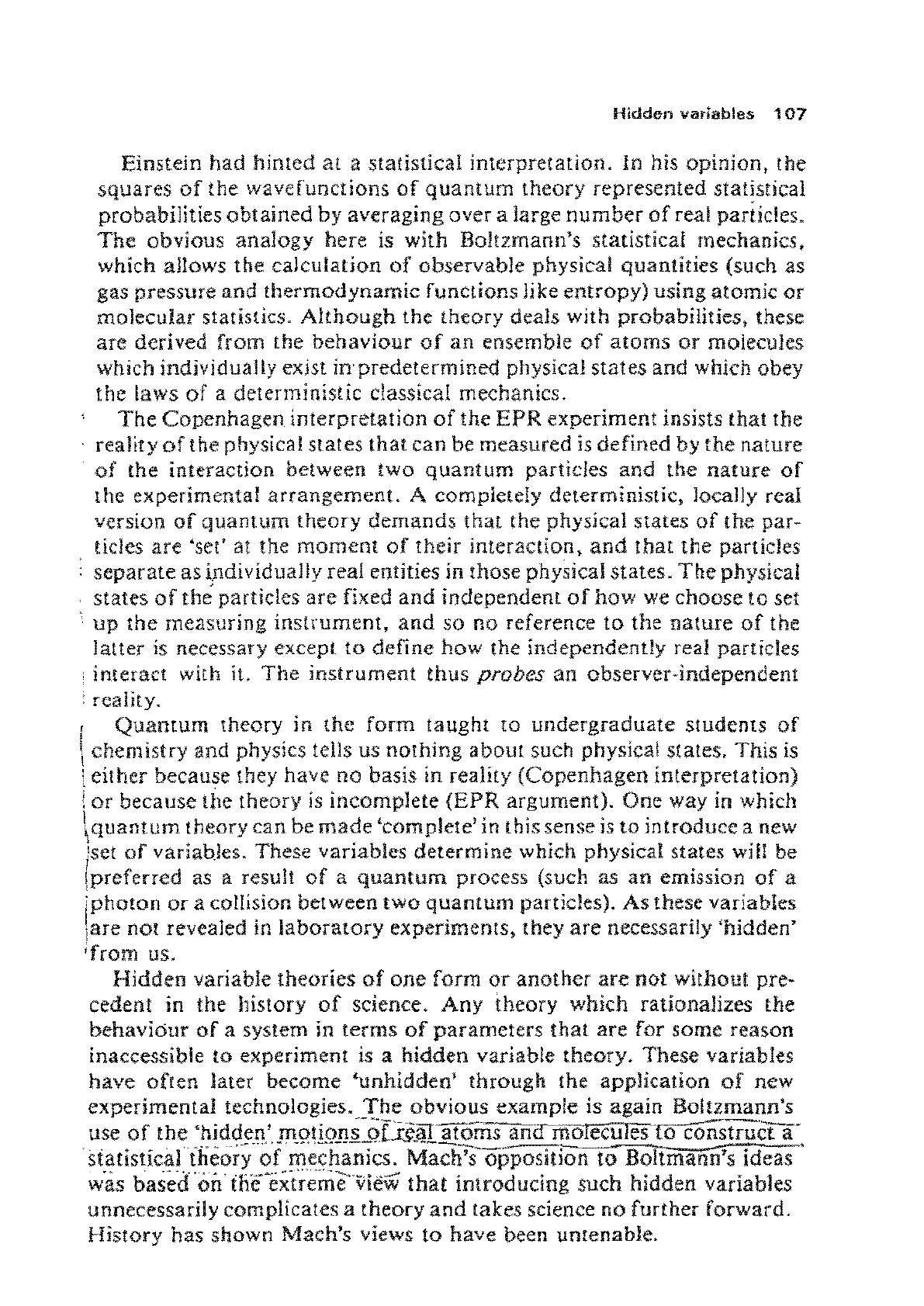
Hidden
variables
107
Einstein had hinted
at
a statistical interpretation. In his opinion, the
squares
of
the wave functions
of
quantum
theory represented statistical
probabilities obtained by averaging over a large
number
of
real particles.
The
obvious analogy here is with Boltzmann's statistical mechanics,
which allows the calculation
of
observable physical quantities (such as
gas
pressure and thermodynamic functions like entropy) using atomic
or
molecular statistics. Although the theory deals with probabilities, these
are derived from the behaviour
of
an ensemble
of
aloms
or
molecules
which individually exist in'predetermined physical states and
which obey
the laws
of
a deterministic classical mechanics.
The Copenhagen interpretation
of
the
EPR
experiment insists thaI the
reality
of
the physical states that can
be
measured
is
defined by the nature
of
the interaction between two
quantum
particles and the nature
of
the experimental arrangement. A completely deterministic, locally real
version
of
quantum theory demands
that
the physical states
of
the par-
ticles
are 'sel' at the moment
of
their interaction,
and
that the particles
separate as individually real
entities in those physical states. The physical
states
of
the
particles are fixed
and
independent
of
how
we
choose to set
,
up
the measuring instrument,
and
50
no reference
to
the nature
of
the
latter is necessary except
to
define how the independently real particles
, interact with
it.
The instrument thus probes an observer-independent
, realily.
,
Quantum
theory in the form taught to undergraduate students
of
II
chemistry and physics tells us nothing about such physical states. This
is
, either because they have no basis in reality (Copenhagen interpretation)
!
or
because tile theory
is
incomplete
(EPR
argument). One way
in
which
\
quantum
theory can be made 'complete' in this sense
is
to introduce a new
'set
of
variables. These variables determine which physical stales will be
(preferred
as
a result
of
a
quanlum
process (such as an emission
of
a
iPhoton
or
a collision between two quantum particles). As these variables
,are
not revealed
in
laboratory experiments, they are necessarily 'hidden'
Ifrom
us.
Hidden variable theories
of
one form
or
another are not without pre-
cedent in Ihe history
of
science. Any theory which rationalizes the
behaviour
of
a system
in
terms
of
parameters Ihat are
fOr
some reason
inaccessible to
experiment
is
a hidden variable theory. These variables
have often later become
'unhidden'
through the application
of
new
experimental technologies.
The
obvious example is again Boltzmann's
use
of
the
<hidd~n'Jm)tjgJ)~S;lZjr~.tomSiU1amoleculesc~tructa-
.
. -
--.
~
,-
--.-~--
statistical theory
of
mechanics. Mach's opposition
to
Boltmann's ideas
w'as
based
on
ilieexi'remeview
that
introducing such hidden variables
unnecessarily complicates a theory
and
takes science no further forward.
History has shown
Mach's views to have been untenable.
